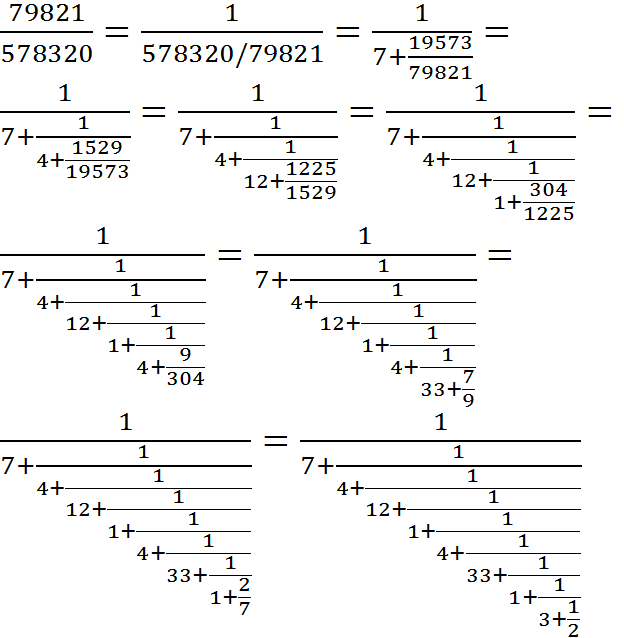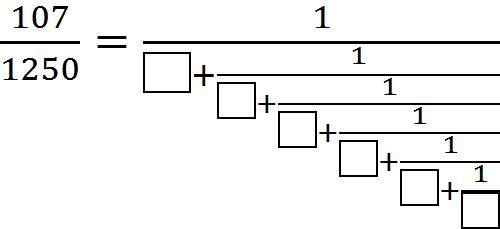reduction
The material related to reduction is expressed in the form of problems.
- Take a number that is expressed as a whole number plus a fraction and express it as a fraction, i.e. express a mixed number as a fraction.
The numerator in the expression is found by multiplying the denominator in the fraction by the whole number and adding it to the numerator.
Example:![]() . ie:
. ie: ![]() .
.
- Reduce a given fraction to its lowest terms.
This is done by finding the greatest common divisor between the numerator and denominator. Then divide the numerator and denominator by this number.
Examples:
(1) Reduce ![]() .
.
255 = 9 × 27 + 12
27 = 2 × 12 + 3
12 = 4 × 3
Therefore 3 is the least common divisor and so 
(2) Reduce ![]() .
.
2268 = 3 × 594 + 486
594 = 1 × 486 + 108
486 = 4 × 108 + 54
108 = 2 × 54
Therefore 54 is the least common divisor and so  .
.
In this second example, Macdonald only got as far as ![]() .
.
- Reduce a mixed fraction to a simple fraction.
There are two cases. When the mixed fraction is composed of fractions, invert the fraction in the denominator. Multiply two numerators together and multiply the two denominators together. When the mixed fraction is composed of mixed numbers, express the mixed numbers as fractions and proceed as in the first case.
Examples:
(1) Reduce ![]() .
. ![]() .
.
(2) Reduce ![]() .
. ![]() .
.
- Reduce a compound fraction to an equivalent simple one.
Reduce all the numbers, be they fractions or mixed fractions, to simple fractions. Then multiply the numerators together and the denominators together.
Example:
Reduce ![]() of
of ![]() of
of ![]() of
of ![]() .
.
This is given by ![]() .
.
- Reduce any number or fraction to a fraction that shall have any proposed denominator.
Express the number as a fraction and multiply it by the proposed denominator.
Examples:
(1) Reduce ![]() to a fractions whose denominator is 25.
to a fractions whose denominator is 25.
![]() . Therefore
. Therefore ![]() .
.
(2) Reduce ![]() to a fraction whose denominator is 16.
to a fraction whose denominator is 16.
![]() . Now
. Now ![]() so that
so that ![]() .
.
- Reduce any number of fractions to equivalent simple fractions that have a common denominator.
Express all the fractions as simple fractions. Then multiply the numerator and denominator of each fraction by the denominators of the others.
Example:
Reduce ![]() ,
, ![]() and
and ![]() of
of ![]() to equivalent simple fractions have a common denominator.
to equivalent simple fractions have a common denominator.
![]() and
and ![]() of is
of is ![]() .
.
Therefore
![]()

![]() of
of ![]()
- Any fraction in its lowest terms being given, to find a series of a simple fraction in terms still lower that shall each express the value of the given fraction as nearly as possible.
The phrase “in its lowest terms” means that the faction has been reduced to the point that the numerator and denominator are relatively prime. The solution is expressed as a continued fraction. To find the continued fraction, divide the numerator into the denominator. This yields a number plus a remainder. The remainder and its divisor is now a fraction. Repeat the procedure until the remaining fraction is 1 divided by some number.
No reason is given in the notebook for looking at continued fractions. It is just a numerical exercise.
Example:
Express ![]() as a continued fraction.
as a continued fraction.

The fraction may be expressed in shorthand as [0; 7, 4, 12, 1, 4, 33, 1, 3, 2] where 0 is the leading integer of the mixed fraction to use Macdonald’s terminology.
Express ![]() as a continued fraction.
as a continued fraction.
i.e. 


